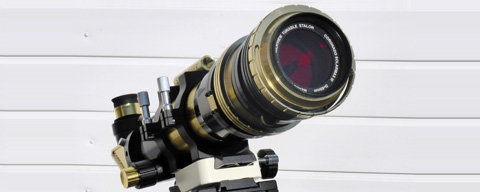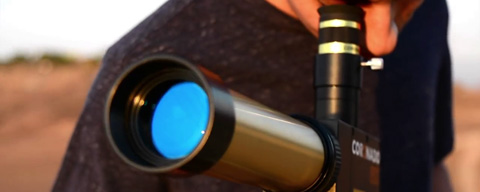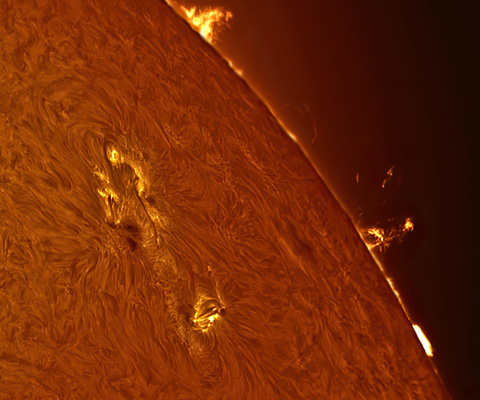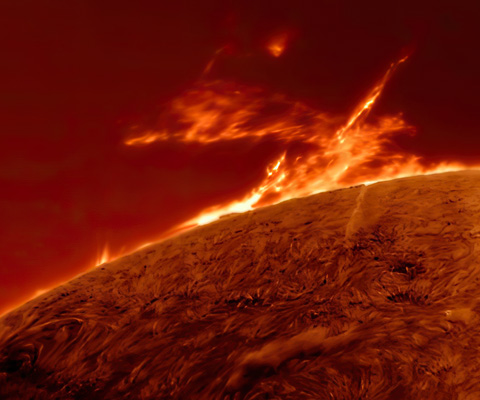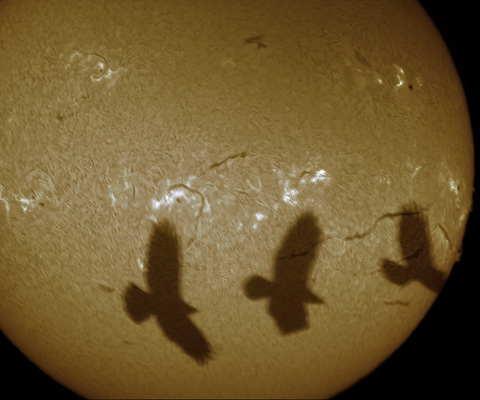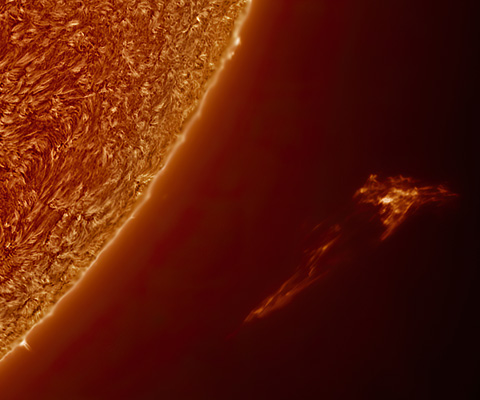Introduction
The Sun is located at the centre of the Solar System and is a star formed around 4.6 billion years ago. It is a sphere of hot plasma that appears as mostly white, radiating energy primarily in the visible spectrum and also infrared wavelengths both of which can observed with an appropriate Solar filter.
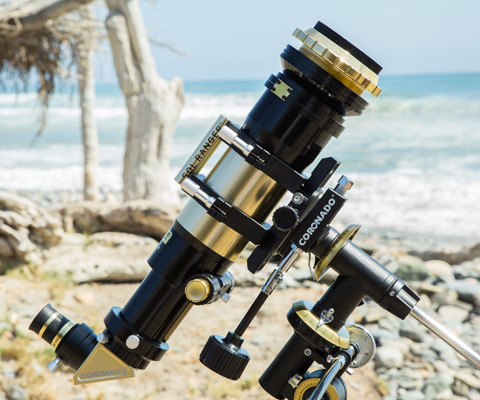
Coronado SolarMax III solar telescope on a mount.
Observing and imaging the Sun with a dedicated Solar scope is a rewarding experience that can be enjoyed during social hours by both casual observers and enthusiasts.
Observing the Sun
A dedicated Solar scope or astronomical telescope with an appropriate Solar filter can be used to observe and image the Sun. Please note that doing so without taking the correct precautions could permanently damage the observer’s eyesight as well as equipment including telescopes, finder scopes and cameras.
Otherwise, the Sun is best observed and imaged through a dedicated Hydrohen-alpha (Ha) Solar scope like the Coronado PST and SolarMax III.
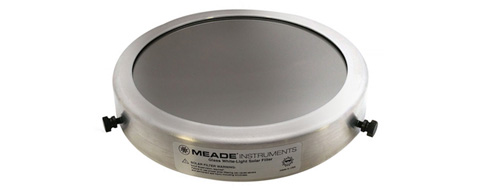
Meade White-Light Solar Filter.
While the Sun can still be observed in white light via an astronomical telescope with the addition of a full aperture energy rejection/White-light filter, the level of detail will be significantly reduced when compared to a dedicated Ha Solar scope.
Nevertheless, Solar spots will show clearly through a White-light Solar filter, surface detail will be minimal where flares and prominences will not be visible. Meade produce and supply the Meade Glass White-Light Solar Filters as seen above, these come in various sizes.
Coronado Personal Solar Telescope (PST)
The Personal Solar Telescope (P.S.T.) is the world's most popular telescope to observe the Sun. The PST is a highly portable dedicated Solar scope with completely internal non-removable solar filtering optics that are ideal for school type environments.
It offers a 1.0 Angstrom Ha bandpass that can be upgraded to 0.5 Angstrom with an optional second etalon that can be easily attached to the front of the scope.
The PST will show the dynamic, ever changing prominences at the edge of the Sun as well as filaments and other surface details, all in the brilliant and distinctive red colour of hydrogen-alpha light.
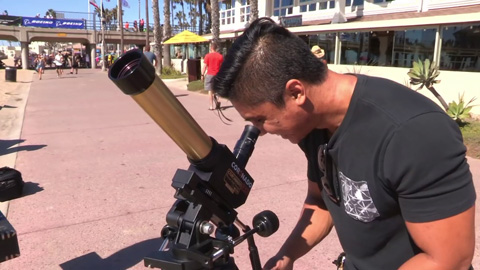
Coronado Personal Solar Telescope (PST).
The PST features a 40mm diameter dedicated Ha optical system with 30mm internal etalon primary blocking filter, incorporated focuser, bandpass fine adjustment controls and built-in solar viewfinder.
A 1/4" thread on its base allows you to attach the PST to a standard photographic tripod making it exceptionally portable.
Coronado SolarMax III
The SolarMax III high resolution Solar scopes are ideal for both observing and imaging the Sun and are used around the world by serious Solar enthusiasts and professional research facilities alike for observation of surface detail and prominences on the Sun in Ha light. With full size ‘true’ Ha etalons (60mm & 90mm) whether single or double stacked, these scopes deliver higher contrast views and sharper features compared with models using smaller internal Ha etalon designs. The benefits include darker backgrounds, sharper features, and higher contrast.
Coronado SolarMax III Double Stack.
Coronado Personal Solar Telescope (PST).
Single stacked Solarmax III scopes offer sub 0.7 Angstrom bandwidth filtering for observation of surface detail and prominences on the Sun in Ha light as well as for high quality imaging. For the dedicated imaging enthusiast, a double stacked SolarMax III offers sub 0.5 Angstrom bandwidth filtering further increasing the level of detail.
The new Meade Coronado SolarMax III represents a breakthrough in Solar observing with the new and revolutionary RichView tuning assembly. This patented system allows direct tuning of the primary filter etalon. No other commercially available Ha telescope can provide the tuning range and accuracy of the SolarMax III. Now you can tune for the highest contrast views of active regions, flares, filaments, and other surface detail, or quickly and easily re-tune for prominences on the solar limb.
Image by Gary Palmer, United Kingdom.
Image by Gary Palmer, United Kingdom.
SolarMax III focuser
The new two-speed 2”/1.25” rack & pinion focuser creates a more user-friendly interaction with the scope offering both coarse and fine focus control allowing the user to get a more precise focus, critical for both Solar imaging and visual observing. In addition, a second inner extendable focuser tube makes the scope compatible with bino-viewers and other less common accessories.
Coronado BF blocking filters
In simple terms, a H-alpha Solar scope typically consists of an etalon in the front and blocking filter (BF) at the back close to or as part of a separate eyepiece holder. Blocking filters come in three sizes i.e., BF10, BF15 and BF30 (10mm, 15mm and 30mm in diameter respectively).
While the physical size of a blocking filter does not have an obvious effect on image quality, larger blocking filters will accommodate larger camera sensors. As such, in most cases a BF10 or BF15 blocking filter will be well suited for observation and most imaging setups, unless your camera has a full frame sensor where a BF30 would be the better choice.
Blocking filters must always be in place when viewing or imaging the Sun with a Solar scope. Using a Solar scope without a blocking filter could permanently damage your eyesight and any accessories connected to the scope including imaging and measuring equipment.
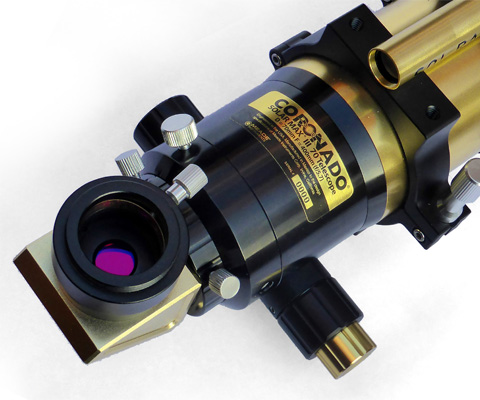
SolarMax III blocking filter and dual speed focuser.
PST
The PST comes with completely internal non-removable solar filtering optics so the blocking filter could not accidentally be left out.
SolarMax III BF10 & BF15
SolarMax III BF10 and BF15 scopes come with user removable blocking filters that are internal to the supplied diagonal. Using a BF10 or BF15 SolarMax III Solar scope without a blocking filter could damage your eyesight and any accessories connected to the scope. These blocking filters must always be in place for both visual and imaging work i.e.,
Observation & imaging: eyepiece or camera ► BF10 or BF15 blocking filter-diagonal ► SolarMax III.
Caution: With safety in mind, always consult your scope’s manual for information on how to use it.
SolarMax III BF30
SolarMax III BF30 scopes come with a removable blocking filter and separate UV blocking diagonal. The supplied blocking filter and diagonal must always be in place for visual observation. However, when imaging with a camera, only the BF30 blocking filter should be used i.e.,
Observation: eyepiece ► diagonal ► BF30 blocking filter ► SolarMax III
Imaging: camera ► BF30 blocking filter ► SolarMax III
Caution:
With safety in mind, always consult your scope’s manual for information on how to use it.
Image by Thomas Wakefield, United Kingdom.
Image by Gary Palmer, United Kingdom.
Accessories
The SolarMax III Solar scopes will accept standard 1.25” eyepieces and will come in focus with a standard bino-viewer, DSLR or C/CS type video camera.
The PST will accept 1.25” eyepieces but you would need a barlow to bring the scope in focus with most cameras including DLSR i.e.,
DSLR body ► T-ring ► T to 1.25” nosepiece ► 1.25” barlow lens ► PST
The quality and type of eyepieces used with Solar scopes in general is very important. Simpler optical designs that use high index glass, take advantage of baffling, darkened lens edges and appropriate coatings can significantly increase image quality.
On the other hand, inadequate and inappropriate designs will absorb/reflect valuable Ha light and be subject to various artifacts and glare readily visible in the eyepiece.
We highly recommend using the Coronado CEMAX range of eyepieces and barlow lens in conjunction with any Coronado Solar scope. These are also very well suited for planetary viewing when used with an astronomical telescope.
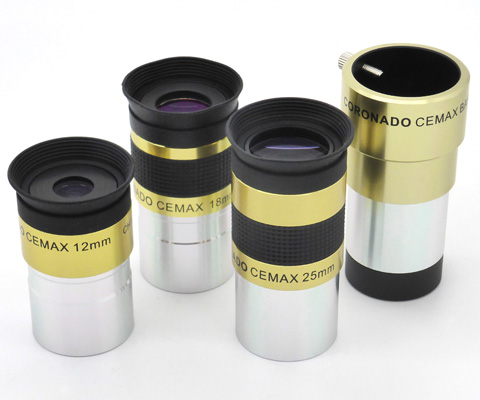
Coronado CEMAX eyepieces and barlow lens.
Related topics:
how-to guide, Personal Solar Telescope, SolarMax III, solar




